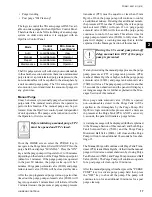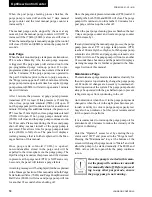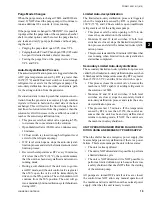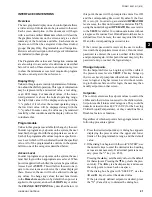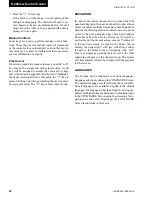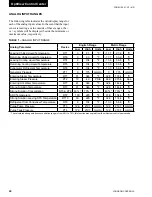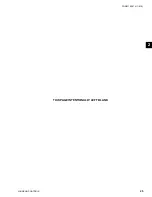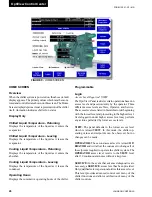
FORM 155.21-O1 (615)
13
JOHNSON CONTROLS
2
setpoint. This allows the chiller to remain running while
adjusting LCHLT to a new setpoint. If a setpoint change
is entered more than once within 5 minutes of the first
entry, the final entry is considered a single change and
the control works to that value and the value before any
entry changes were made. The 30 minute delay for cy-
cling shutdown temp entered does NOT apply to remote
command setpoint changes.
The unit can be stopped at any moment by pressing the
main switch to the stop position, by receiving a stop order
remotely when the unit is in remote mode, when there is
a scheduled stop or by requesting a soft shutdown on the
user interface.
When the unit is stopped using the main switch or by
applying a scheduled stop, the control valve closes and a
dilution cycle is performed immediately. When the unit is
stopped remotely with a soft shutdown selected or by a lo-
cal soft shutdown. The loading of the unit will be linearly
decreased on a user programmed ramp down time to the
valve unload limit (programmed at SERVICE access from
10% to 20%) before shutting the unit down, and then a
dilution cycle is performed. This results in less shock to
the customer's steam/hot water supply system.
Once the Soft Shutdown initiates ramp down, it will
continue until the user defined unloading threshold is
met, regardless of any run/stop status change before
shutdown.
If the unit is operating under a load condition that is equal
to the low unload limit setpoint, when the soft shutdown
is initiated, the unit will go into an instant shutdown.
Automatic Load Control
Three subcontrols interacting constantly determine load
valve position. They are "Leaving Chilled Liquid Tem
-
perature Control (LCHLT Control)", "Strong Solution
Control (SCC Control)" and load limits. The control
performs an analysis of all of them and never exceeds
the lowest limit.
Leaving Chilled Liquid Temperature
(LCHLT) Control
The "Leaving Chilled Water Temperature Control" is a
fuzzy logic control, to match the leaving chilled liquid
temperature with leaving chilled liquid temperature
setpoint.
Strong Solution Concentration (SSC) Control
The "Strong Solution Concentration Control" is a fuzzy
logic control; to avoid the unit reaching concentrations
that can crystallize the solution.
Load Limits
Additionally, the following limits may exist:
• Pulldown Limit Active; if True, the control limits
the max. load to the pulldown current load value.
• Soft shutdown in process; if True, the control lim
-
its the max. load to the ramp down current load
value.
• Remote Control active; if True, the load should NOT
be more than remote load limit setpoint.
• Warning activated; panel will display a warning
message that is further explained in the Messages
Section of this manual.
• Max. Load Limit; programmed valve position
limit.
Limiting Capacity by mixing Solution &
Refrigerant
Isoflow chillers are equipped with provisions to accom
-
modate low load operation (down 10%) with cooling
water temperature as low as 45°
F (7.2
°C). Achievement
of low capacity at low cooling water temperature requires
reduction of concentration in the solution circuit. Water
from the refrigerant circuit is added to the solution circuit
for dilution naturally by operating the unit at low load.
Further load reduction occurs by sending Lithium Bro
-
mide under a controlled basis to the refrigerant circuit.
The amount of actual Lithium Bromide transferred is kept
to a minimum by introducing this Lithium Bromide only
when the refrigerant level in the refrigerant circuit is at a
minimum operational level.
The unloader valve (3SOL) is opened when the upper
refrigerant float/level switch (1F) opens and the leav
-
ing chilled water temperature is greater than 2°F above
setpoint. This temperature threshold prevents transfer of
solution during possible low refrigerant level at start-up
by blocking out the operation of 3SOL until the chilled
water temperature is within range of normal operation.
The refrigerant level solenoid (unloader control) 3SOL
Valve is energized (open) to transfer solution from the
solution (absorber on 50Hz models YIA-10E3 - YIA 14F3
with Franklin Pumps) pump discharge to the refrigerant
pump suction when a low level of refrigerant would oth-
erwise cause refrigerant pump cavitation.

















